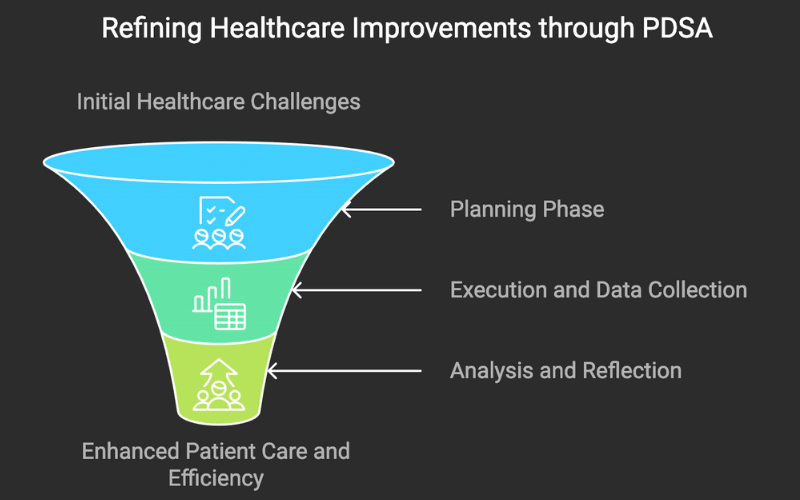PDSA, or Plan-Do-Study-Act, is a cycle used for continuous improvement in various fields, especially healthcare. It involves planning a change, implementing it, studying the results, and acting on what is learned. This cycle helps teams continuously refine their processes. In this article, you’ll learn about the PDSA cycle, how it works, and how to apply it effectively.
Quick PDSA Insights:
- The PDSA cycle (Plan-Do-Study-Act) is an iterative model critical for continuous improvement, emphasizing learning and adaptation through real-world feedback.
- Implementing PDSA cycles in healthcare requires careful planning and execution, focusing on measurable changes to enhance patient care and operational efficiency.
- Common challenges in PDSA implementation include misapplication of principles and inconsistent documentation, which can hinder the effectiveness of quality improvement efforts.
Understanding the PDSA Cycle
The PDSA cycle, standing for Plan-Do-Study-Act, is an iterative model designed for continuous improvement. This structured approach, often referred to as the PDSA or PDCA cycle, is instrumental in enhancing learning and knowledge for ongoing improvement in products, processes, or services. But what makes this cycle so effective?
Its iterative nature ensures that each cycle informs the next, promoting a culture of continuous learning and evidence-based improvement. Small-scale tests of change within the PDSA cycle enable teams to refine their approaches using real-world feedback. This emphasis on iterative development is what distinguishes PDSA from other improvement methodologies.
Origins of PDSA
The PDSA cycle originates from the realms of manufacturing and quality control, with significant contributions from Walter Shewhart and Edward Deming. Initially referred to as pdca cycles (Plan-Do-Check-Act), the terminology evolved to PDSA under Deming’s influence to underscore the critical importance of studying results rather than merely checking them. This evolution reflects the broader understanding of pdsa and pdca cycles in quality improvement.
Deming’s teachings advanced the use of the PDCA cycle, which laid the groundwork for the PDSA process we use today. The shift from ‘Check’ to ‘Study’ reflects a deeper commitment to learning from outcomes and predicting future improvements, aligning with the Deming cycle.
Key Components of PDSA
The PDSA cycle consists of four key stages: Plan, Do, Study, Act. During the Plan phase, teams define their objectives and plan the test or change. In the Do phase, the plan is executed, and observations are documented. The Study phase involves analyzing the results and determining if the objectives were met. Finally, in the Act phase, teams decide whether to adopt, adapt, or abandon the change based on what was learned.
This cycle is not a one-time event but an iterative process where each cycle informs the next cycle, promoting continuous improvement. Writing down each step helps maintain focus and enhances learning during implementation.
Implementing PDSA Cycles in Healthcare

Implementing PDSA cycles in healthcare is crucial for driving improvements in patient care and operational efficiency. These cycles are designed to support iterative development and scientific testing of changes within healthcare settings. The structured approach of PDSA cycles allows for rapid testing and adaptation, directly impacting patient outcomes.
In healthcare, the primary aim of the PDSA cycle is to implement significant changes that enhance patient care and streamline processes. Local context and social systems play a critical role in the success of PDSA interventions, necessitating a tailored approach to each setting.
Planning Phase
The planning phase, a cornerstone of the PDSA cycle, involves setting clear objectives and assembling a diverse team to harness various insights and strengths. The PDSA project planning form is essential for describing the change and its objectives. A comprehensive problem statement helps prioritize issues and justify the choices made.
After recruiting the team, it is important to identify roles, set timelines, and establish a meeting schedule to ensure smooth progress.
Execution and Data Collection
During the execution phase, the planned changes are implemented, and relevant data is collected. This step includes both quantitative and qualitative assessments to ensure a thorough understanding of the impact. Collecting data effectively is vital for evaluating the success or failure of changes.
During this phase, documenting problems, unexpected observations, and general observations is vital. Patient and staff reactions, as well as any modifications to the plan, should also be recorded.
Analysis and Reflection
Analysis and reflection are critical for identifying lessons learned and planning future cycles. The study phase of the PDSA cycle involves analyzing data to determine if the desired improvements were achieved. This process enables teams to determine what worked, what didn’t, and what changes are necessary for future cycles.
Effective integration of qualitative and quantitative data enhances understanding and informs better decision-making. Thorough documentation at each stage is crucial for facilitating learning and ensuring accountability.
Tools and Resources for PDSA Cycles
Several tools and resources can aid in the effective implementation of PDSA cycles. The PDSA Worksheet is a key tool for documenting tests of change in quality improvement efforts. Structured planning forms and checklists also significantly enhance the process.
Visual tools like swim lane maps are also helpful for describing processes and capturing the steps involved in the PDSA cycle. Such resources improve planning, execution, and analysis of improvement initiatives.
PDSA Worksheets
PDSA worksheets assist teams in documenting the Plan-Do-Study-Act cycles effectively, including the study act pdsa. These worksheets, available in both Word and PDF formats, cater to different user preferences and are essential for maintaining records of the tests of change.
These worksheets typically include multiple cycles to demonstrate the iterative nature of the process. Translations are also available in Spanish and Portuguese, making them accessible to a broader audience.
Data Collection Tools
Various data collection tools are vital for the PDSA cycle. Check sheets are commonly used to organize data collection. Run charts and control charts are effective tools for tracking changes over time and monitoring process behavior during the PDSA cycles.
Such tools enhance understanding of the data and assist teams in making informed decisions based on real-time feedback.
Further Reading
For those looking to deepen their understanding of PDSA cycles, ‘The Improvement Guide’ is a highly recommended resource. This book provides comprehensive guidance on planning and executing PDSA cycles. Additionally, the PDSA Form and Checklist, along with project planning forms, can aid in effective implementation.
Online platforms and forums where practitioners share experiences and insights on PDSA cycles provide valuable resources for advanced learning. Access to various resources is crucial for mastering the PDSA cycle and applying it effectively in different contexts.
Real-world Examples of PDSA in Action
Real-world examples of PDSA in action demonstrate its effectiveness in driving healthcare improvements. These cycles allow teams to test changes quickly, often on a small scale, and refine them as necessary.
By examining specific cases, we can see how PDSA cycles have led to significant improvements in patient care and operational efficiency.
Improving Patient Wait Times
One notable example of PDSA in action is the initiative to reduce patient wait times in an emergency department. Using PDSA cycles, the team implemented systematic changes to improve the patient experience.
The KASCH ED project, which utilized the Canadian Triage and Acuity Scale, and the Pediatric Rapid Assessment and Management (PRAM) model, significantly decreased patient wait times. These methods underscore the effectiveness of PDSA cycles in achieving measurable improvements in emergency department wait times.
Enhancing Pain Management Protocols
Another example is the iterative testing of pain management protocols using PDSA cycles. By incorporating feedback at each stage, the team was able to refine pain management strategies, leading to improved patient satisfaction and reduced pain levels during recovery.
This example highlights the importance of feedback and iteration in clinical settings, demonstrating how PDSA cycles can drive significant improvements in patient care.
Common Challenges and Solutions in PDSA Implementation
While the PDSA cycle is a powerful tool, its implementation is not without challenges. Common issues include inconsistent application, publication bias, and a lack of scientific rigor in reporting.
Addressing these challenges is crucial for maximizing the effectiveness of PDSA cycles in healthcare improvement efforts.
Misapplication of PDSA Principles
A frequent error in applying PDSA principles is the failure to adhere to its fundamental characteristics, leading to ineffective outcomes. Studies have shown that many applications of PDSA do not align with its primary features, which compromises the effectiveness of the method.
Ensuring proper application and avoiding the temptation to make multiple changes in a single cycle is essential for achieving the desired improvements.
Ensuring Consistent Documentation
Thorough documentation at each stage of the PDSA cycle is crucial for maintaining focus and facilitating learning during the implementation of changes. Documentation can be categorized into four levels, ranging from no detail to detailed descriptions of individual cycles and their stages.
Consistent documentation ensures that all team members are aligned and that the learning from each cycle is captured and used to inform future cycles.
Balancing Qualitative and Quantitative Data
Balancing qualitative and quantitative data is essential for gaining comprehensive insights during PDSA cycles. Integrating both types of data provides a clearer picture and improves decision-making.
Teams should ensure consistent collect data and regularly review the interactions between qualitative data and quantitative data to enhance their understanding of the scientific method changes being tested.
PDSA Summary
The PDSA cycle is a robust framework for driving continuous improvement in healthcare. By understanding its origins, key components, and practical applications, healthcare teams can harness its power to achieve better patient outcomes and operational efficiency.
Embracing the iterative nature of PDSA and addressing common challenges will ensure that this methodology delivers on its promise of quality improvement. Start your journey with PDSA today and witness the transformative impact on your practice.
Frequently Asked Questions Around PDSA
What is the PDSA cycle?
The PDSA cycle, which stands for Plan-Do-Study-Act, is an iterative model designed for continuous improvement in processes and practices. It promotes systematic testing of changes to enhance outcomes effectively.
How does the PDSA cycle differ from the PDCA cycle?
The PDSA cycle differs from the PDCA cycle primarily in its focus on the ‘Study’ phase, which prioritizes learning from outcomes rather than merely checking results. This shift underscores the significance of understanding the impact of changes implemented.
Why is documentation important in PDSA cycles?
Documentation is crucial in PDSA cycles as it ensures focus, facilitates learning, and maintains consistency throughout the process. This structured approach ultimately enhances the effectiveness of each cycle.
How can PDSA cycles improve patient wait times?
PDSA cycles can significantly improve patient wait times by enabling the systematic testing and refinement of processes. This iterative approach helps identify and address inefficiencies, ultimately enhancing patient flow and service delivery.
What tools are essential for implementing PDSA cycles?
Essential tools for implementing PDSA cycles include the PDSA Worksheet, check sheets, run charts, and control charts, which facilitate systematic tracking and analysis. Utilizing these tools ensures a structured approach to continuous improvement.
 Principals: Be the Leader Your Teachers Need. Unite Your Team Before May.
Principals: Be the Leader Your Teachers Need. Unite Your Team Before May.


